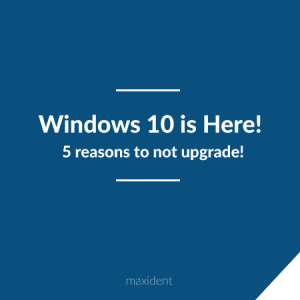With much fanfare, Windows 10, Microsoft’s latest and final operating system, was introduced to the world on July 29. If first impressions mean anything, Windows 10 looks to be a vast improvement over the colossal misstep of Windows 8, and a solid foundation for Microsoft to build its new perpetual operating system plan on. With all the hoopla over Microsoft’s free Windows 10 upgrade offer, the calls have already started pouring in from our customers asking whether they should make the move. And so far our answer has been an unreserved, “No.”

- The free upgrade offer is good for a whole year so there is no rush to cash in on it right away.
- One of the main selling points of Windows 10 is that it abandons the almost universally despised Windows 8 interface – losing the “Charms” bar and restoring the Start button – making the user experience more like Windows 7. So if you’re still using Windows 7, from a usage point of view, there isn’t any reason to rush to switch.
- Microsoft will not be discontinuing security updates for Windows 7 and Windows 8 anytime soon. Support for Windows 7 will run until January 2020 and for Windows 8 until January 2023.
- Old printers, scanners or other attached legacy devices may not work. Microsoft has never guaranteed that drivers for legacy hardware will work with new operating systems – and all too often they don’t. If you have devices attached to your computer, you need to be sure that they are Windows 10 compatible drivers available for them.
- You don’t want to be a guinea pig. Even the most rigorous pre-release testing of a major software release won’t find all the bugs. There will always be hardware and software compatibility issues that only come to light once the operating system goes into general release and members of the public start to scream. It is better to wait for the dust to settle and the fixes to be released than to be one of the ones feeling the pain.
Upgrading too quickly to a brand new and largely untried operating system is never a good idea. There are always issues discovered once an operating system goes into general release. Sometimes these inevitable problems are relatively minor and can be corrected with a few Windows patches or driver updates. Sometimes it takes a while to achieve a degree of relative perfection – Windows XP SP2 – and sometimes the OS is such an irredeemable failure – anyone remember Windows ME? – there is no salvation and it has to be junked.
Which of these will Windows 10 be? If I had to guess, I’d say Windows 10 is going to be a keeper – and Microsoft is betting the farm on it. But still, before rushing out to install, consider this: in the first three weeks of its release, Microsoft reported that Windows 10 had been installed on over 14 million machines. In that same period, there also pushed out three cumulative update bundles to fix bugs and patch security holes in their new OS. That’s a lot of people, discovering a lot of problems.
Generally speaking, unless you’re feeling adventurous, it’s a good idea to wait at least six months after a new operating system has been released before considering switching to it. Many large corporations wait years after an operating system has been released before they are satisfied it is worth the time and trouble to make the move. So sit back and wait for the kinks to get worked out of the (operating) system. Windows 10 is going to be around for a long time yet, so why not bide your time and play it safe?



